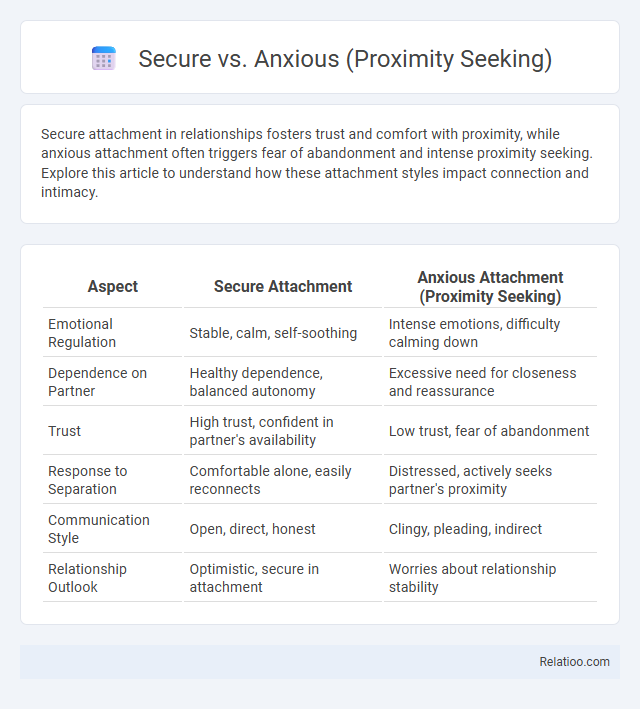Secure attachment in relationships fosters trust and comfort with proximity, while anxious attachment often triggers fear of abandonment and intense proximity seeking. Explore this article to understand how these attachment styles impact connection and intimacy.
Table of Comparison
| Aspect | Secure Attachment | Anxious Attachment (Proximity Seeking) |
|---|---|---|
| Emotional Regulation | Stable, calm, self-soothing | Intense emotions, difficulty calming down |
| Dependence on Partner | Healthy dependence, balanced autonomy | Excessive need for closeness and reassurance |
| Trust | High trust, confident in partner's availability | Low trust, fear of abandonment |
| Response to Separation | Comfortable alone, easily reconnects | Distressed, actively seeks partner's proximity |
| Communication Style | Open, direct, honest | Clingy, pleading, indirect |
| Relationship Outlook | Optimistic, secure in attachment | Worries about relationship stability |
Understanding Attachment Styles: Secure vs Anxious
Secure attachment entails confidence in the availability and support of close others, fostering healthy proximity seeking behaviors that promote emotional safety and trust. Anxious attachment drives heightened proximity seeking due to fears of abandonment, leading to clinginess and emotional hypervigilance in relationships. Understanding these attachment styles clarifies how individuals regulate closeness and maintain connection, influencing relationship quality and emotional well-being.
Core Characteristics of Secure Attachment
Secure attachment is characterized by comfort with intimacy and trust in relationships, allowing you to seek closeness without fear of abandonment or anxiety. Core characteristics include effective emotional regulation, confidence in the availability of caregivers, and balanced autonomy with connection. Unlike anxious or overly proximity-seeking individuals, securely attached people maintain stability and resilience in emotional bonds.
Core Characteristics of Anxious Attachment
Anxious attachment is characterized by intense proximity seeking, driven by a fear of abandonment and a heightened need for reassurance from caregivers or partners. Individuals with this attachment style often display clinginess, emotional volatility, and hypersensitivity to relational cues, contrasting with the more balanced and confident closeness found in secure attachment. Core traits include persistent worry about rejection, difficulty trusting others fully, and a cycle of seeking closeness while fearing being too dependent.
The Role of Proximity Seeking in Relationships
Proximity seeking plays a crucial role in attachment styles, shaping how individuals maintain closeness in relationships. Secure individuals seek proximity with confidence, fostering trust and emotional safety, while anxious individuals engage in heightened proximity seeking driven by fear of abandonment. This behavioral difference highlights how proximity seeking regulates emotional connection and attachment security between partners.
Emotional Responses in Secure vs Anxious Individuals
Secure individuals exhibit balanced emotional responses to proximity seeking, showing comfort and trust when close to attachment figures, which fosters healthy emotional regulation. Anxious individuals often respond with heightened emotional intensity and fear of abandonment during proximity seeking, leading to increased stress and dependency behaviors. These contrasting emotional patterns affect relationship dynamics and attachment security, highlighting the importance of adaptive emotional regulation in secure attachments.
Communication Patterns: Security and Anxiety
Secure attachment in communication is marked by clear, consistent, and open emotional expression, fostering trust and understanding between individuals. Anxious attachment often leads to heightened proximity seeking behaviors, with frequent checking-in, intense emotional exchanges, and fears of abandonment driving the dialogue. Your communication patterns benefit from recognizing these dynamics, allowing you to modulate proximity seeking in ways that promote emotional security and connection.
Impact on Relationship Satisfaction and Stability
Secure attachment fosters high relationship satisfaction and stability through consistent emotional availability and trust. Anxious (proximity seeking) attachment often leads to lower satisfaction and instability due to heightened dependence and fear of abandonment. Proximity seeking behavior intensity correlates with attachment style, significantly influencing relationship dynamics and long-term commitment.
Triggers for Proximity Seeking in Anxious Attachment
Triggers for proximity seeking in anxious attachment primarily include feelings of insecurity, fear of abandonment, and doubts about the partner's availability or responsiveness. You may find yourself seeking constant reassurance and closeness to alleviate anxiety triggered by perceived threats to the relationship. Unlike secure attachment, where proximity is sought for comfort and connection, anxious attachment drives intense proximity seeking as a response to emotional distress and the need for validation.
Developing Secure Attachment: Steps and Strategies
Developing secure attachment involves recognizing and addressing anxious proximity-seeking behaviors that often stem from insecurity and fear of abandonment. You can foster secure attachment by consistently providing emotional availability, responsive communication, and validating feelings to create trust and safety in relationships. Practicing mindfulness and self-regulation techniques also supports reducing anxious dependence while promoting healthy, balanced closeness.
Navigating Relationships with Different Attachment Styles
Navigating relationships with different attachment styles requires understanding Secure, Anxious, and Proximity Seeking behaviors to foster healthy connections. Secure attachment promotes trust and open communication, enabling you to build stable bonds, while Anxious attachment often drives excessive need for reassurance and closeness. Recognizing Proximity Seeking as a natural desire for connection helps you respond empathetically, balancing sensitivity with boundaries to maintain relationship harmony.

Infographic: Secure vs Anxious (Proximity Seeking)
 relatioo.com
relatioo.com